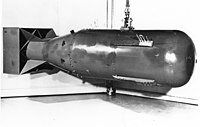
Photo from wikipedia
Accurate and timely information on yield forecasting is necessary for policymakers in decision-making. The case study was planned to develop a framework for the regional wheat yield forecasting model for… Click to show full abstract
Accurate and timely information on yield forecasting is necessary for policymakers in decision-making. The case study was planned to develop a framework for the regional wheat yield forecasting model for southeastern Turkey. Therefore, after implementing Top of Atmospheric (TOA) correction for all images and collecting ground-truthing point of 313 fields from the Nurdagi and Islahiye counties. A total of eight machine learning algorithms were tuned and tested for the satellite image classification so that best model was used for the spatial distribution of wheat crop. The results of machine learning algorithms showed an accuracy greater than 90%. As the best model, the random forest was used for image classification. The classification results showed that area estimated by the classifier were 11% more than those reported by the Turkish statistical department. The observed and predicted yield of the tested model was closed to each other with root mean square error (RMSE) of 198 kg ha−1. The observed and predicted yield showed a close agreement with RMSE of 144 kg ha−1 at Nurdagi and 68 kg ha−1 at Islahiye for 5 years. It is concluded that remote sensing is useful tools for estimation of yield and developed can be used for other regions and crops.
Journal Title: Journal of the Indian Society of Remote Sensing
Year Published: 2020
Link to full text (if available)
Share on Social Media: Sign Up to like & get
recommendations!